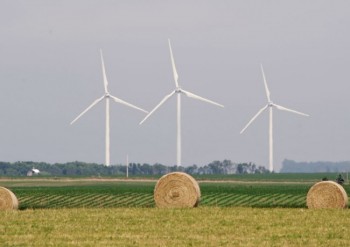The Gift of South Dakota
Subscriptions to South Dakota Magazine make great gifts!
Subscribe today — 1 year (6 issues) is just $29!
The Real Cost of Renewable Energy
May 7, 2012
I took a few minutes last week to determine what wind and solar energy actually cost. Proceeding on the assumption that the real cost of a turtle is how much cash ends up in the hands of the turtle seller, per shell, I wondered how much consumers pay for a given unit of energy and how much other money producers get for various forms of energy generation.
The average price of residential electricity in the U.S. is about 12 cents per kilowatt hour but varies widely by state, according to the Energy Information Administration. In South Dakota it is nine cents. In Alaska it is almost twice that and in Hawaii, three times that. Doing a quick conversion, Americans pay on average about $120 per megawatt hour for electricity.
That is not quite the price of electricity, for energy producers also receive state and federal subsidies. Add the subsidy to the retail price and you get a reasonable estimate of the real cost. The Institute for Energy Research calculated the cost of federal subsidies from the EIA’s production reports. I cannot find anywhere that the EIA actually tells us what we need to know here: subsidies per unit of energy produced.
The IER finds that in 2007 natural gas and petroleum liquids received about $0.25 in Federal subsidies for every megawatt hour produced. Coal gets $0.44; hydroelectric, $0.67; and nuclear power gets $1.69. About 87% of our electricity is produced from those sources. Given that, the subsidies add up to considerable amounts of money. The total increase is still only a small fraction of the cost of the energy.
In 2007, subsidies for wind and solar power per megawatt hour were $23 and $24 respectively. That obviously dwarfs the subsidies for conventional sources and it means that electricity from these sources costs considerably more. A megawatt hour from coal would cost $120.44. A megawatt hour of wind or solar generated electricity costs $144.
That was back in 2007. As a result of the stimulus bill, subsidies to all sources of energy increased, but the subsidies for renewables ballooned. Here are the numbers for 2010:
For solar power, they were $775.64 per megawatt hour, for wind $56.29, for nuclear $3.14, for hydroelectric power $0.82, for coal $0.64 and for natural gas and petroleum liquids $0.64.
That means that wind energy is now costing over $170 per unit. Solar power is off the charts at almost $900. I admit some astonishment that the solar industry in the U.S. is not booming rather than wobbling. At that level of reimbursement, you’d think they’d be giving away whole house solar instillations for joining Netflix.
Proponents of renewable energy will argue that there are large costs involved in fossil fuel production and consumption (environmental degradation, health, etc.). That may be true, but it gets the cart before the horse. One turtle may be cooler than another and one form of energy generation may be more desirable than another. That doesn’t change how much the turtle or the megawatt hour costs.
It misses something else, equally important. Subsidies shift wealth from one place to another. Wealth shifted to renewables is wealth generated by non-renewables. As long as the subsidies last, they don’t reduce the secondary costs of traditional energy.
What they do accomplish, with mathematical certainty, is to make energy more expensive in the short run. This is not ruinous only because the renewables produce less that 3% of our electricity. Of course, it may be that the subsidies will eventually kick in and wind and solar power will dramatically increase production while prices fall precipitously. Is there any sign that that is happening? How efficient would these machines have to become (10 times as efficient?) and how much turf would we have to cover with pinwheels and panels before these sources constituted 20% of electricity generation?
Wind power and solar power are pretty ideas. They have been the sources of the future for as long as the monorail has been the transportation of the future. Maybe one day they will really pan out. Right now, these industries are neither producing jobs nor economic growth. They are absorbing both.
Dr. Ken Blanchard is a professor of Political Science at Northern State University and writes for the Aberdeen American News and the blog South Dakota Politics.








Comments
I'm all for green energy, but have to agree that it has to make some sense. I was disappointed over the big hub-hub to start a South Dakota-owned wind farm, and went to the meeting. But the whole point wasn't to create a locally owned project or to create cleaner energy, but only to milk a federal incentive for 6 or 7 years and then to re-sell it once the incentive was dry.
We've got to separate the profiteers from the serious researchers and developers.
This sort of clever work and coverage! Keep up the terrific works guys I've incorporated you guys to my blogroll.